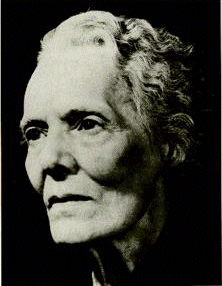 Having rejected Victorian norms for modern experiments, H. D. repeatedly launched out from instructors found among the early canonized male modernists. She developed new lyric, mythic, and mystical forms in poetry and prose, and an alternative bisexual lifestyle that were little appreciated until the 1980’s. Her literary contacts included Ezra Pound, Marianne Moore, William Carlos Williams, Ford Madox Ford, May Sinclair, Dorothy Richardson, Richard Aldington, Bryher, D. H. Lawrence, T. S. Eliot, Djuna Barnes, Gertrude Stein, Amy Lowell, Norman Douglas, Edith Sitwell and Elizabeth Bowen. She was the literary editor of the Egoist (1916-1917), and admired the work of James Joyce and Virginia Woolf. Younger poets like Robert Duncan, Allen Ginsberg, May Sarton, and Denise Levertov took her as a mentor. H. D.’s literary papers are at Beinecke Library, Yale University.
Having rejected Victorian norms for modern experiments, H. D. repeatedly launched out from instructors found among the early canonized male modernists. She developed new lyric, mythic, and mystical forms in poetry and prose, and an alternative bisexual lifestyle that were little appreciated until the 1980’s. Her literary contacts included Ezra Pound, Marianne Moore, William Carlos Williams, Ford Madox Ford, May Sinclair, Dorothy Richardson, Richard Aldington, Bryher, D. H. Lawrence, T. S. Eliot, Djuna Barnes, Gertrude Stein, Amy Lowell, Norman Douglas, Edith Sitwell and Elizabeth Bowen. She was the literary editor of the Egoist (1916-1917), and admired the work of James Joyce and Virginia Woolf. Younger poets like Robert Duncan, Allen Ginsberg, May Sarton, and Denise Levertov took her as a mentor. H. D.’s literary papers are at Beinecke Library, Yale University.
Autobiographies
H. D. was born into the Moravian community of her artistic, musical mother, Helen (Wolle), in Bethlehem, Pennsylvania, and reared in Upper Darby, a Philadelphia suburb convenient to the University of Pennsylvania. Her astronomer father, Charles, was director of the Flower Observatory there. The Gift (written 1941-1944; published 1982) is cast in the inquiring voice of a child, who is cognizant of several generations of her family, and of her own dreams and fantasies. Her grandmother ultimately bestows a sense of her self-enabling heritage or “gift,” and its mystical connection to the Moravians. Mystical access to the past through visions and the reading of “signets” – signs or heiroglyphs requiring patient deciphering – is essential to all of H. D.’s autobiographical writing.
H.D.’s autobiographical writings from the middle years of her life are invaluable to the study of the gendered politics of experimental modernism, and the place of the female analysis and in psychoanalysis. Ezra Pound entered her life while she was still a schoolgirl in Pennsylvania. In verses written for her, Pound gave her the persona of the “dryad,” which persisted among her many self-concepts. They were twice engaged. Barbara Guest has suggested that his tutelage interfered with her studies at Bryn Mawr, which she quit in her second year. She did meet another as yet undeclared poet, Marianne Moore, while there (1904-1906). H. D. joined the same literary circles Pound traveled in when she moved to London in 1911. In a famous incident of 1913, he sent some of her verse to Harriet Monroe’s Poetry Magazine, appending the signature “H.D., Imagiste.” They served as models of the new poetry he was promoting. End to Torment: A Memoir of Ezra Pound by H. D. (written 1958; published 1979) explores this
relationship.
With Bid Me to Live (written 1933-1950, published 1960), H. D. writes herself out of what Rachel Blau Du Plessis has called “romantic thralldom” with two other literary men. She married the British poet, Richard Aldington, in 1913. Having enlisted in World War I, his fictional counterpart called for her sustaining letters to the front, yet resented her sharing verses with “Rico,” the D. H. Lawrence counterpart, and flaunted his infidelities. Lawrence had a charismatic effect upon H. D. during the war years in London, but discouraged her creation of male subjects in her poetry, and objected to her relationship with Cecil Grey, the painter whom she joined in Cornwall. Grey became the father of her only surviving child, Frances Perdita Aldington (born 1919). H. D. had been anguished over the still-birth of a daughter fathered by Aldington in 1915, and the death of her brother Gilbert at the front. Bid Me to Live was part of a “madrigal cycle,” including also Paint it To-Day and Asphodel (neither yet fully published). All of these works intertwined the painful demands of war and love relationships, as does the brilliant long poem, Trilogy (written 1944-1946), with its images of rebirth taken from classical, Egyptian and Christian sources.
Tribute to Freud (written 1944; published gradually from 1945-1985) offers a third creative re-vision of male-inspired paradigms. H. D. was analyzed by Freud in 1933 and 1934, in an attempt to overcome writer’s block. She also underwent analysis with Hans Sachs in the 1930s, with Erich Heydt in the 1950s, and was treated with intervenous shock therapy, following a major breakdown in 1946. Freud encouraged her to write straight history to break out of the personal crisis she experienced during World War I. With Bid Me to Live she felt she was escaping also from the influence of psychoanalysis; she did revise Freud’s role as analyst to something more like a medium. Spiritualism became an overriding interest in the 1940’s. Communication with the dead and projections from another realm were regular tropes in her writing, including her last writing, HermeticDefinition.
Bisexuality
H.D.’s troubled alliance with Pound was mingled with her love of Frances Josepha Gregg, a student at the Pennsylvania Academy of Fine Arts, and the recipient of some of her earliest poems. Gregg and her mother were H. D.’s companions onthe 1911 trip to
London. Prefiguring other bisexual triangles she would involve herself in, H. D. planned to accompany Gregg on her honey moon, but was prevented from doing so by Pound. The strains between lesbian and heterosexual attractions, experienced over the Gregg relationship, entered into H. D.’s novel HERmione (written 1927, the year before Radclyffe Hall’s lesbian novel, The Well of Loneliness, was the subject of an obscenity trial; published 1981).
The novelist and editor Bryher (Winnifred Ellerman, an heiress to a shipping fortune), was the most significant companion of her mature life. Their relationship survived until H. D.’s death in 1961, spanning Bryher’s two marriages of convenience to Robert McAlmonand Kenneth Macpherson, in circumstances that included significant travel and residences mainly in London and Switzerland. H. D. has credited Bryher with saving her life during the final months of her pregnancy in 1919, when she was struck with influenza. Bryher and H. D. traveled to the Scilly Islands together in June 1919, for a month of idyllic companionship;
they went to Greece (sailing by Lesbos) with H. D.’s mother in 1922, and traveled to Egypt the next year. The women made a creative trio with the artist and filmmaker Kenneth Macpherson from 1927 to 1932; Macpherson became H. D.’s lover, and Bryher’s husband, and the married couple adopted H. D.’s daughter Perdita. Their collaborations included photo montages, the film journal Close Up, to which H. D. supplied poetry and reviews, and Borderline, a film in which H. D. starred with Paul Robeson. The project is one indication of H. D.’s literary connections to the Harlem Renaissance, and her attraction to the margins of modernism. Much of H.D.’s poetry published in the 1930’s and 1940’s appeared in Life and Letters Today, edited by Bryher.
H.D. was well informed about contemporary theories of homosexuality, due both to her analysis by Freud, who pronounced her bisexual, and her friendship with sexologist Havelock Ellis, whom she met in 1919. But she was not limited to their views, particularly in HER. Her shift in interest to mother-daughter dynamics in Notes on Thought and Vision may have been a transference out of Freud’s influence. However, Ellis failed to appreciate her revolutionary “bell jar” experiences of pregnancy and the unconscious, recorded in Notes on Thought and Vision, and his lack of enthusiasm may have discouraged her publishing it.
Critical Repositioning and Feminist Criticism
For many years H. D. was known chiefly for the stark, chiseled images and experimental rhythms of her earliest work, collected as
Sea Garden (1916). This fit the imagist program of Ezra Pound. She also had a limited reputation as a classicist and translator of Greek. Feminist critics, led by Susan Stanford Friedman and Rachel Blau DuPlessis, have studied H.D.’s works for feminine lesbian, and bisexual discourses. Since the early 1980’s H. D.’s epic and prose writing have received more attention, and work self-suppressed in her own lifetime has been recovered and studied. H. D.’s frequent recourse to the palimpsest can be seen as anescape from binary and hierarchical thinking associated with patriarchy. The term denotes a parchment that retains
partially erased parts of earlier writings, which strain productively with new text. She titled a three-part story sequence Palimpsest (written 1923-1924), but the term also applies to her rewritings of her own selfhood in autobiographies, and to her rewritten myths. H. D. can be credited with anticipating the maternal semiotic of Julia Kristeva, and with giving a female voice to classical myths. Sandra Gilbert (“H. D.? Who Was She?,” Contemporary Literature 24 [1983]:496-511) suggests that she developed a “woman’s mythology” in Trilogy, Helenin Egypt, and Hermetic Definition. Alicia Ostriker (“Thieves ofLanguage,” Signs 8, no. 1 [1982]: 68-90) includes H. D. among women poets who construct new myths to include their selves. H. D.’s Greek texts, culminating in Helen in Egypt, explore the divinity of the goddess, the sexually ecstatic Eleusinian mysteries, and the female version of patriarchal epics. A criticism from Lawrence S.Rainey (“Canon, Gender and Text,” Representing Modern Texts, ed. George Bornstein, [1991]) is that in recent years H. D.’s work has been studied for the sake of content conducive to feminist solidarity, rather than aesthetic value. Yet this criticism neglects feminist critics’ remarks on the formal devices of mythic mask, palimpsest, and return of the repressed, characteristic of life-writing cure, that moved H. D. beyond confinement to the divisive gender stereotypes of her day.
